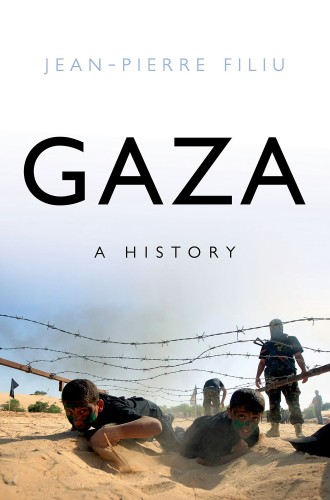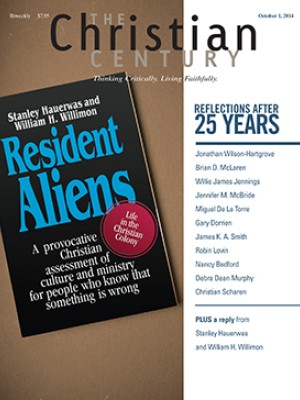Gaza: A History, by Jean-Pierre Filiu
How to begin to describe the Gaza Strip, which came into existence with the 1948 war—the War of Independence for Israelis and the nakba, or catastrophe, for Palestinians?
As I write this review, the Israeli military has begun a ground offensive into Gaza following days of Israeli aerial bombardment and rocket fire from Hamas and other Palestinian fighters. Many Israelis view Gaza as a hotbed of terrorism to be cordoned off and battered into submission, while for many Palestinians Gaza represents a six-decade-long disaster but also Palestinian endurance and resistance.
A fuller description of the Gaza Strip must go beyond the spectacular violence of the present moment. One could begin with basic geographic and demographic facts: the Gaza Strip has one of the world’s highest population densities and one of the world’s fastest growing populations, with over 1.8 million people living in a 141-square-mile territory (25 miles long and between four and seven miles wide), bounded by Egypt, the state of Israel, and the Mediterranean Sea, which is patrolled by the Israeli military. One could highlight Gaza’s rich history, underscoring its strategic location next to the sea and its role as a key stopping point for caravans traveling between Egypt and the Arabian peninsula. One could stress that Gaza has been shaped over the centuries by Egyptian, Philistine, Byzantine, Crusader, and Islamic civilizations and could point to architectural gems like the Greek Orthodox Church of St. Porphyry, the Great Omari Mosque, and the still-functioning 14th-century bathhouse, Hamam al-Sammara. One could describe various aspects of Gaza’s vibrant cultures, as Laila El-Haddad has done in her delightful cookbook/ethnography The Gaza Kitchen: A Palestinian Culinary Journey.
Read our latest issue or browse back issues.
Or one could adopt the approach taken by Jean-Pierre Filiu, professor of Middle East studies at the Paris School of International Affairs at France’s Sciences Po, and focus on Gaza’s central role in the Palestinian national movement, especially after 1948. In Gaza: A History, Filiu offers a helpful corrective to narratives of Palestinian nationalism and resistance that focus on the West Bank or the Palestinian diaspora. Filiu reminds us that by the end of the 1948 war, the newly created Gaza Strip had become home to one quarter of the Palestinian population of the Palestine Mandate. Refugees had been driven into the Strip from their former dwellings in the Naqab desert, coastal towns like al-Majdal and Asdud, and even as far afield as Galilee. Today over two-thirds of the Gaza Strip’s inhabitants are refugees registered with the United Nations, with many of those refugees living in the Strip’s eight UN-operated refugee camps. Gaza is starkly representative of how the experience of exile has shaped Palestinian identity.
The core of Filiu’s study is divided into three sections. In the first, “The Age of Mourning,” Filiu examines the Palestinian resistance that coalesced in Gaza’s refugee camps in the wake of the nakba. In the second section, “The Crushed Generation,” he looks at how Palestinians in Gaza adjusted to Israel’s military occupation of the Strip, and in the third, “The Generation of the Intifadas,” he considers Gaza’s leading role in the first intifada, the formation of the Palestinian National Authority in the wake of the Oslo Accords and its “Gaza-Jericho First” approach, and the outbreak of the second intifada as the hopes of the Oslo peace process crumbled.
Filiu’s history of Gaza has several strengths, first and foremost his focused insistence on moving Gaza from the margins to the center of Palestinian history. Filiu also capably narrates the roots of Palestinian Islamism in the Gaza Strip, explaining how today’s Hamas emerged from the Mujamma founded by Sheikh Ahmed Yassin in the early 1970s as a competitor to the Palestine Liberation Organization’s secular-nationalist politics, embodied by Fatah and various leftist parties. And he helpfully describes the shifting tensions between secular nationalism and Islamism within the Palestinian national movement.
Filiu’s study suffers from a failure to let Gazans speak for themselves. He quotes very few Gazans directly or indirectly, whether from archival material such as newspapers and memoirs or from oral interviews. Although he does a fine job of narrating history as a succession of events, material presenting Gazans in their own words would have added depth and texture to his account.
One other way to describe the Gaza Strip is to view it as emblematic of the Israeli state’s territorial, military, and economic strategies. Filiu touches on this approach in his introductory and concluding chapters. He cites Harvard political scientist Sara Roy’s analysis of Israel’s politics of “de-development” in the Gaza Strip from 1967 onward, with Gazans becoming both a source of cheap labor and a captive market for Israeli products. This lasted until Israel began shifting away from its dependence on Palestinian day labor and toward reliance on temporary foreign workers from East Asia and elsewhere.
The Oslo-era dream of Gaza becoming an “Asian tiger” has long since dissolved: the United Nations estimates that nearly 1 million Gazans rely on food aid, and Israel’s stringent and punitive control over Gaza’s borders renders any real economic development impossible. Filiu notes that the Gaza Strip is routinely described as the world’s largest open-air prison, a description that is difficult to argue with after one has passed through the militarized checkpoint apparatus at the Erez Crossing, the northern entrance to the Strip.
In these instances, Gaza is not unique but is emblematic of the experience of the Occupied Palestinian Territories as a whole since 1967. According to Israeli political theorist Adi Ophir, the Gaza Strip and the West Bank alike have been subject to a rule of “inclusive exclusion.” They have been included territorially and economically within sovereign Israeli control but excluded politically as Israel has pursued a policy of “maximum land, minimum Arabs.” As Israeli colonization has expanded and accelerated over the past four decades, the zones to which Palestinians are confined and the movement among those zones have become increasingly restricted, thanks to Israeli-only roads, a network of checkpoints, and separation walls and militarized fences. This territorial fragmentation, not surprisingly, has gone hand in hand with Palestinian political fragmentation. Gaza is simply an extreme example of these trends.
Few Christian pilgrims to the Holy Land visit the Gaza Strip. The Israeli military, which controls entrance into Gaza, tightly limits entry, having decided that there are no valid pilgrimage or tourism reasons to visit Gaza. Many Christian communions around the world support and advocate for a two-state solution to the Palestinian-Israeli conflict, but an unflinching look at Israel’s territorial fragmentation of the Occupied Territories, with Gaza’s enforced isolation being an extreme example, should raise serious questions about whether a two-state solution to the conflict remains possible. The future to which Gaza’s present reality points is bleak.
Hope, it would seem, is in short supply. Yet spend some time with Gazans like the workers at the Near East Council of Churches in Gaza City or with women who organize after-school clubs for children and youth in Khan Younis, and you will come away impressed and moved by the resilience of people living under such harsh conditions. Or spend time with Israeli peace-building organizations like Zochrot and New Profile and you will see alternatives to militarism, dispossession, and revenge. Studies like Filiu’s are valuable for underscoring the grim severity of the present situation and for recounting the history that produced it. But hope for the future is in Palestinians’ and Israelis’ patient and determined work toward a politics that is not captive to the violent strategies of separation and partition that have created the human disaster gripping Gaza.






